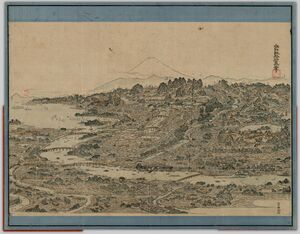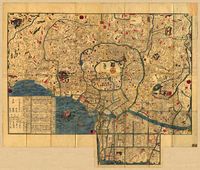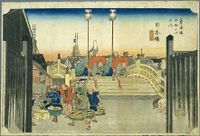إدو
Edo
江戸 | |
|---|---|
مدينة سابقة | |
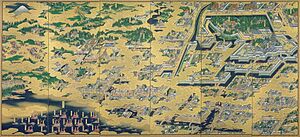 Folding screen view of Edo in the 17th century, showing Edo Castle on the upper right corner | |
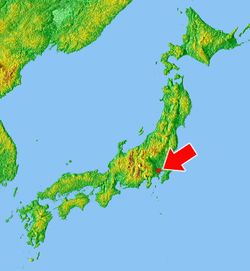 الموقع السابق لإدو والموقع الحالي لطوكيو | |
| الإحداثيات: 35°41′22″N 139°41′30″E / 35.68944°N 139.69167°ECoordinates: 35°41′22″N 139°41′30″E / 35.68944°N 139.69167°E | |
| البلد | |
| المقاطعة | موساشي |
| تشييد قلعة إدو | 1457 |
| عاصمة الأمر الواقع | 1603 |
| تغير اسمها لطوكيو | 1868 |
| الحكومة | |
| • Type of leader | Feudal government |
| التعداد (1721)[1] | |
| • الإجمالي | 1٬000٬000 |
إدو (江戸, Edo, حرفياً "مدخل الخليج" أو "مصب النهر") هو الاسم القديم لمدينة طوكيو في اليابان، وإليها نسبت الفترة المعروفة بـ"فترة إدو" من التاريخ الياباني والتي صاحبت حكم أسرة "توكوگاوا" للبلاد.
Edo, formerly a jōkamachi (castle town) centered on Edo Castle located in Musashi Province, became the de facto capital of Japan from 1603 as the seat of the Tokugawa shogunate. Edo grew to become one of the largest cities in the world under the Tokugawa.
After the Meiji Restoration in 1868 the Meiji government renamed Edo as Tokyo (東京, "Eastern Capital") and relocated the Emperor from the historic capital of Kyoto to the city. The era of Tokugawa rule in Japan from 1603 to 1868 is known as the Edo period.
. . . . . . . . . . . . . . . . . . . . . . . . . . . . . . . . . . . . . . . . . . . . . . . . . . . . . . . . . . . . . . . . . . . . . . . . . . . . . . . . . . . . . . . . . . . . . . . . . . . . . . . . . . . . . . . . . . . . . . . . . . . . . . . . . . . . . . . . . . . . . . . . . . . . . . . . . . . . . . . . . . . . . . . .
تاريخ
منذ تأسيس مكاتب الشوگون في إيدو أصبحت كيوتو العاصمة السابقة لليابان، حيث تحولت العاصمة بحكم الحال إلى إيدو لأنها أصبحت مركز السلطة السياسية الحقيقية. ومنذ ذلك الوقت نمت إيدو بشكل متسارع من قرية صيد صغيرة في عام 1457 إلى عاصمة متحضرة يقطنها أكثر من مليون نسمة عام 1712 وكانت أكبر مدينة في العالم في ذلك الوقت.[1][2]
قبل تكوگاوا
Before the 10th century, there is no mention of Edo in historical records, but for a few settlements in the area. Edo first appears in the Azuma Kagami chronicles, that name for the area being probably used since the second half of the Heian period. Its development started in late 11th century with a branch of the Kanmu-Taira clan (桓武平氏) called the Chichibu clan (秩父氏), coming from the banks of the then-Iruma River, present day upstream of Arakawa river. A descendant of the head of the Chichibu clan settled in the area and took the name Edo Shigetsugu (江戸重継), likely based on the name used for the place, and founded the Edo clan. Shigetsugu built a fortified residence, probably around the tip of the Musashino terrace, which would become the Edo castle. Shigetsugu's son, Edo Shigenaga (江戸重長), took the Taira's side against Minamoto no Yoritomo in 1180 but eventually surrendered to Minamoto and became a gokenin for the Kamakura shogunate. At the fall of the shogunate in the 14th century, the Edo clan took the side of the Southern court, and its influence declined during the Muromachi period.
In 1456, a vassal of the Ōgigayatsu branch of the Uesugi clan, started to build a castle on the former fortified residence of the Edo clan and took the name Ōta Dōkan. Dōkan lived in this castle until his assassination in 1486. Under Dōkan, with good water connections to Kamakura, Odawara and other parts of Kanto and the country, Edo expanded in a jokamachi, with the castle bordering a cove opening into Edo Bay (current Hibiya Park) and the town developing along the Hirakawa River that was flowing into the cove, as well as the stretch of land on the eastern side of the cove (roughly where current Tokyo Station is) called Edomaeto (江戸前島). Some priests and scholars fleeing Kyoto after the Ōnin War came to Edo during that period.
After the death of Dōkan, the castle became one of strongholds of the Uesugi clan, which fell to the Later Hōjō clan at the battle of Takanawahara in 1524, during the expansion of their rule over the Kantō area. When the Hōjō clan was finally defeated by Toyotomi Hideyoshi in 1590, the Kanto area was given to rule to Toyotomi's senior officer Tokugawa Ieyasu, who took his residence in Edo.
عهد تكوگاوا
تعرضت إدو للعديد من الحرائق المدمرة منها حريق ميريكي الكبير عام 1657 الذي راح ضحيته أكثر من 100 ألف شخص.
في عام 1868 عندما آلت شوگونية توكوگاوا إلى نهايتها مع بدء إصلاح ميجي، تمت إعادة تسمية إيدو إلى طوكيو والتي تعني "العاصمة الشرقية" وانتقل الإمبراطور إليها من إقامته السابقة في كيوتو.
جغرافيا

عرفت المدينة بإحاطتها لقلعة إدو، حيث تعرف المنطقة المحيطة بالقلعة مباشرة باسم يامانوته والتي كانت تضم بشكل رئيسي بيوت الإقطاعيين (دايميو)، كما كانت تضم كثافة كبيرة من محاربي الساموراي.
وبالابتعاد قليلا عن مركز المدينة نجد مايسمى شيتاماتشي 下町(المدينة السفلى) والتي كان يسكنها الصناع والحرفيين يعرفون باسم تشونين (町人) إلى الشمال الغربي من القلعة في مناطق مثل أساكوسا و أوينو.
يجري نهر سوميدا على طول لالحافة الشرقية للمدينة والتي كان على طوله يتوضع مخازن أرز الشوگون والمكاتب الرسمية له بالإضافة إلى أشهر مطاعم المدينة.
يتوسط المدينة ما عرف في السابق باسم "جسر إدو" (江戸橋، إدو-باشي)(نيهونباشي حالياً) والذي كان يعتبر المركز التجاري للمدينة حيث يتجمع الصيادين والحرفيين والتجار لعرض بضائعهم وتبادلها عبر البحر أو البر، وبقيت تلك المنطقة هي المنطقة المالية لطوكيو حتى اليوم.
معرض
انظر طوكيو لصور فوتوغرافية للمدينة الحديثة.
اقرأ أيضا
- مجتمع إدو
- الحرائق في إدو
- 1703 Genroku earthquake
- إدوكـّو (مواطن إدو)
- طوكيو
- فترة إدو
- تاريخ طوكيو
- إيكي (مثل أعلى ياباني للجمال)
- أساكوسا
مراجع
| هل أنت مهتم باليابان؟ ستجد الكثير من المعلومات في بوابة اليابان. |

